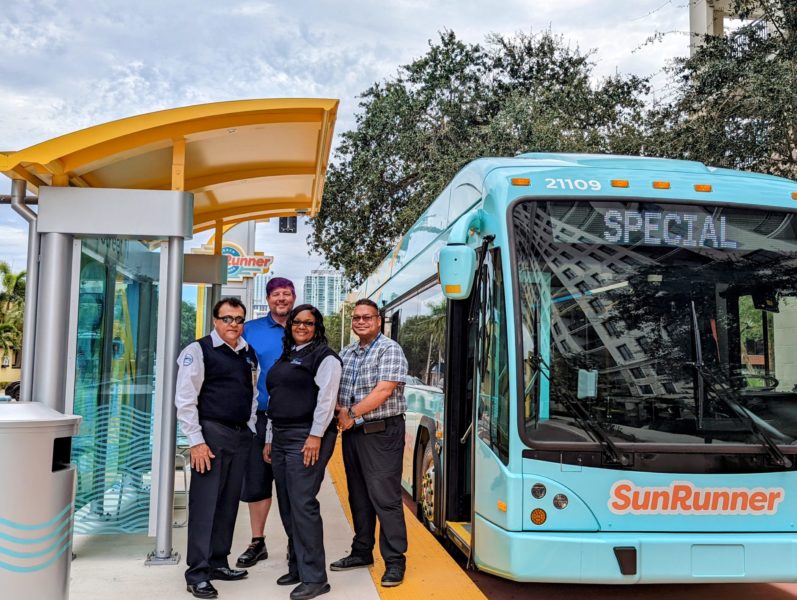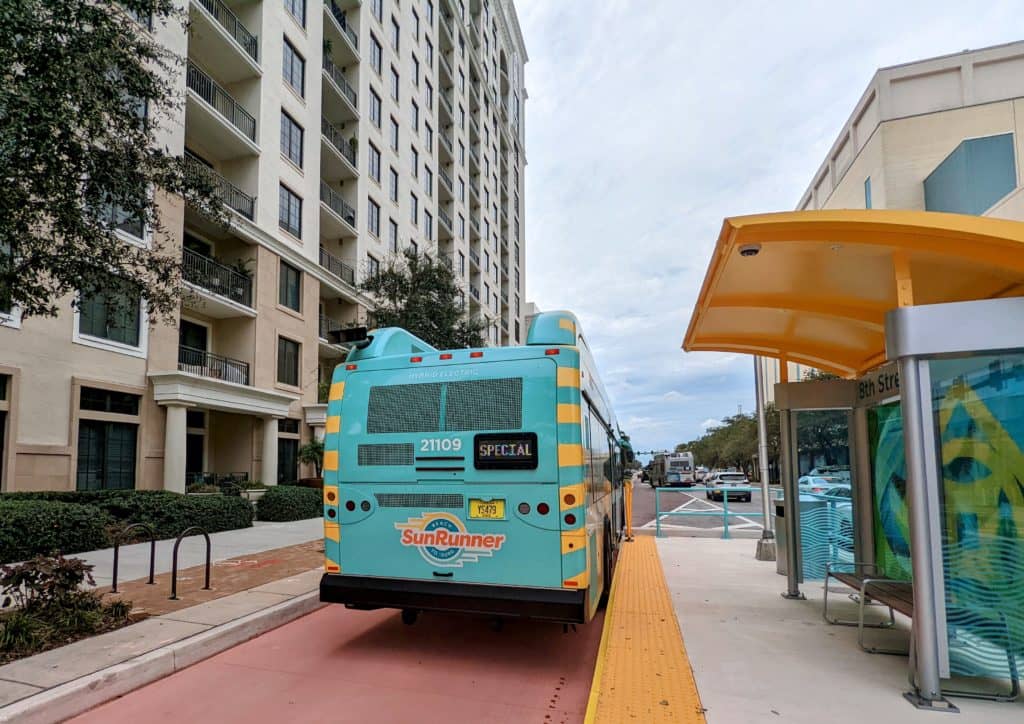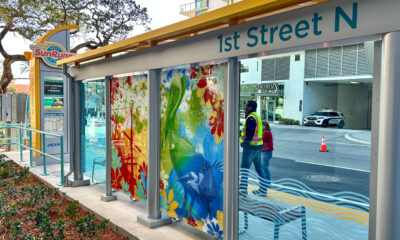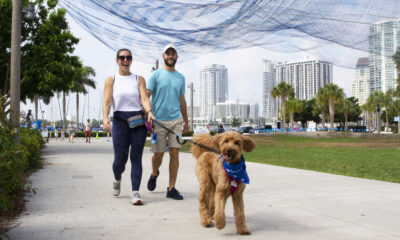Know
Inside Tampa Bay’s first bus rapid transit service

The long-awaited SunRunner is ready to debut in St. Petersburg, connecting the city and beaches with semi-dedicated lanes and attention to minor details.
The Pinellas Suncoast Transit Authority will host a ribbon-cutting ceremony Oct. 20 for the $44 million bus rapid transit (BRT) service – the first in the region. The SunRunner will make its maiden voyage transporting the public Friday, Oct. 21, and offer free rides for the first six months. Ahead of the festivities, the Pinellas Suncoast Transit Authority (PSTA) offered media a peek behind its teal sliding doors for a quick trip.
The BRT bus pulls in flush against the curb at its 30 stations along a 10.3-mile route that connects St. Petersburg, South Pasadena and St. Pete Beach. Eschewing stairs allows for easier access, especially for those with disabilities. In addition to shorter drive times and fewer stops, Sonia Jones, a PSTA bus operator, said the on-level boarding presented the most significant variation to her old routine. “You just pull up to them,” she said.

Operators like Sonia Jones trained for eight months.
A.J. Ortiz, lead safety and security instructor, said training on the new vehicles began in late January and lasted eight months. Operators could not prepare for the transition on local roadways, so PSTA officials built a facility to practice in a controlled environment.
The raised platforms, said Ortiz, present a hazard for the buses as drivers pull into the stations with little margin for error.
“The most difficult thing I had to train was almost like teaching a bad habit,” explained Ortiz. “We stay away from curbs. Curbs are bad – that’s where people are. Now, we have a raised platform, and … you got to touch the curb.”
He added that there are tools to protect the busses, but if operators pull in at an angle, “things could easily go wrong.”
Ortiz called the training intricate, and instructors split the course into four modules. The SunRunner features television screens that provide weather and news and will eventually offer marketing and promotions. He said officials adopted the feature after several operators suggested it during those sessions.
PSTA employs about 400 drivers, and Ortiz said the BRT needs 14 to 20 dedicated operators for its nine SunRunners to ensure coverage.
St. Pete Beach, Ortiz noted, is perennially ranked among the nation’s best, and he said there is not enough parking to accommodate its popularity. Officials designed the SunRunner for people to bring coolers, beach chairs and bicycles, which lock into place inside the bus utilizing an easy-to-use mechanism.

Officials designed the busses to accommodate coolers, beach chairs, bicycles and wet and sandy passengers.
While Ortiz said the BRT “has definitely created more work for us,” the ultimate goal is customer satisfaction.
“We want to make sure the customer has what they need,” he said. “And can cut down travel times … and have less congested roads. It’s a win-win.”
The BRT will transport people to the beaches every 15 minutes from 6 a.m. until 8 p.m. and every 30 minutes from 8 p.m. until midnight. After the first six months, the cost is the same as a typical bus ride: $2.25. Officials expect some boisterous and possibly intoxicated passengers, but Jones said she is unconcerned with that aspect.
If she is pleasant with people, explained Jones, they typically return the favor. “If they’re not out of control, it’s OK.”
“They’re here having a good time,” she said. “They’re not going far.”
Ortiz noted those people are doing the right thing by utilizing the service rather than having a “road soda” and driving.
SunRunner’s designers utilized a rubber, texturized floor with channels to mitigate moisture and slipping. Oritz also noted they tried to make cleaning a preponderance of sand easier.
Each of the SunRunner’s seats comes equipped with USB charging ports, another one of the “little details” he said PSTA took into consideration. The bus is quiet and accelerates quickly.
Ortiz relayed that several residents in St. Petersburg’s luxury condos previously complained of fumes. So, PSTA implemented geofencing technology that prevents buses from operating the diesel engine in the downtown corridor.
Once the bus leaves the designated area, Ortiz said the engine restarts to charge the electric motor.
“Pinellas County residents, regardless of who you are or where you live, they have a voice,” he said. “We listen, and here is the end result.”
While some people have complained about the red-painted SunRunner lanes causing confusion and increasing congestion, Ortiz said the benefits outweigh the costs. During the demonstration, a vehicle stopped at a light in the BRT’s lane, temporarily impeding its path.
He believes the complaints stem from people’s reluctance to change, which the area needs to accommodate growth.
“Will this lead to a future BRT going north and south?” he asked. “I’d like to hope so.”

Rides are free for the first six months, and the first 500 passengers will receive gold cards that offer discounts and promotions.
Beginning Oct. 21 at 6 a.m., PSTA will give the first 500 passengers a SunRunner gold card. It offers discounts to over 30 businesses along the route.
For more information, visit the website here.








Mike C
October 24, 2022at3:36 pm
Happy to see some people decided to take if for a ride. I dont see the value proposition by reserving a lane of traffic to a bus which comes every 15 min or so. Lets see what the ridership looks like after the free rides end. What is the ROI? Operating costs? Breakeven point? Most Americans continue to like to drive not ride.
rob
October 17, 2022at10:40 am
there was already a shuttle to the beach that went down central and it was not over crowded? This seemed like overkill
Joyce Michele
October 16, 2022at12:03 am
This is great and brings to mind the very popular Denver downtown transits ans the airport shuttles in Colorado!
Amber Bennett
October 15, 2022at10:17 am
I probably won’t use it often, if at all. But I’m glad that my fellow residents who need clean, safe and affordable transportation are getting it!
Laurell Leverock Kimbrough
October 15, 2022at7:50 am
Sorry, but I think this is a ridiculous waste of taxpayer money. Who is really going to use this? How about parking on either end? Plus, our wonderful east/west route is now narrowed and annoying.